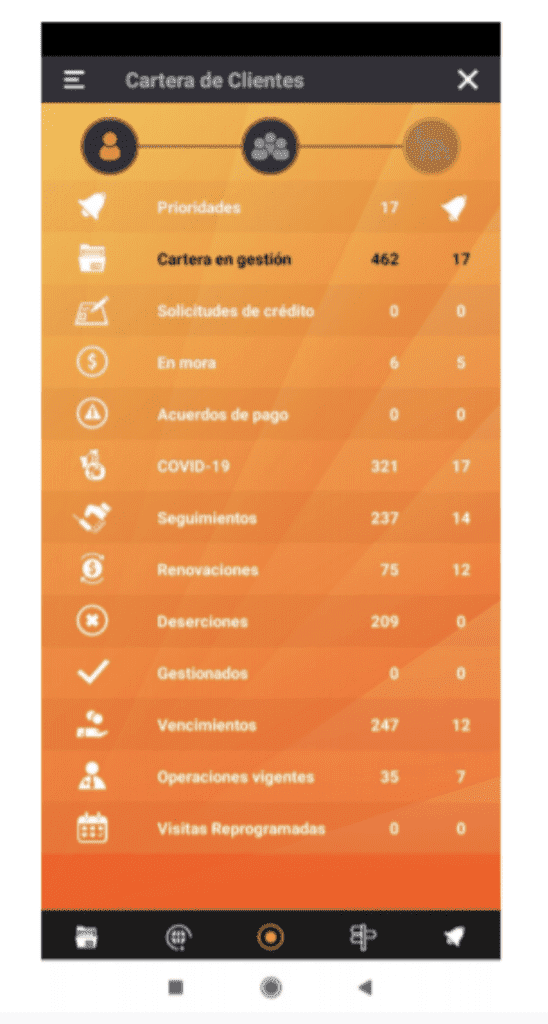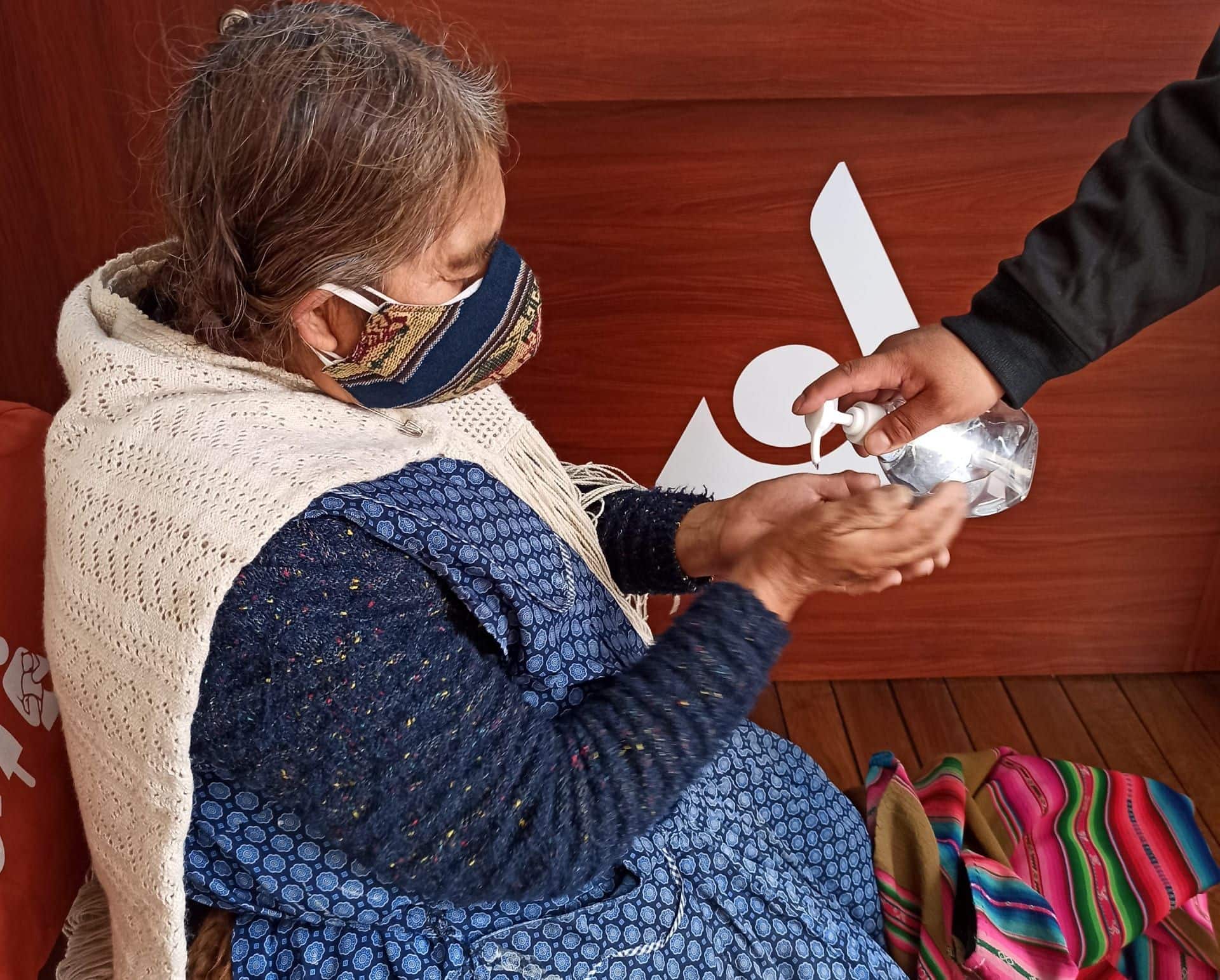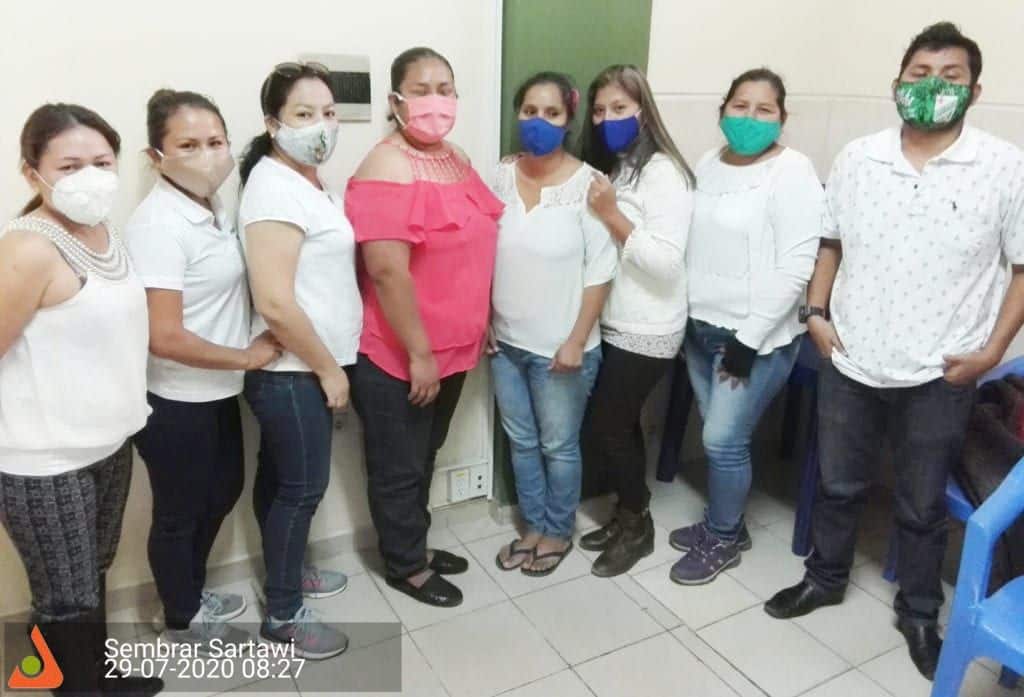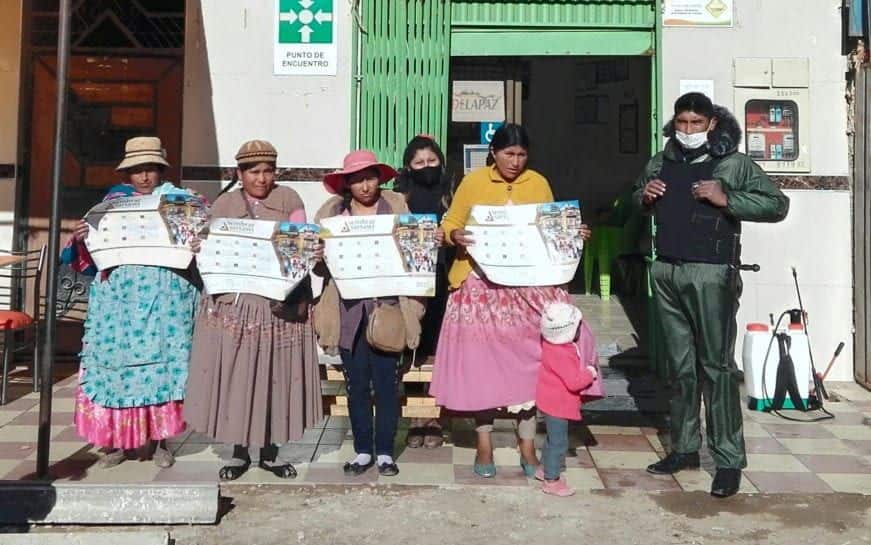Prompted by interest from our network of microfinance partners, WPF organized two webinars to bring together our Latin American and Caribbean network of microfinance partners. The first call, in June 2020, gathered ten microfinance institutions to discuss how each was managing the COVID-19 crisis; if and how they were disbursing and collecting from clients; and if and how they were convening Communal Bank group meetings. The second webinar, in July 2020, engaged three organizations to moderate a conversation with seven additional partners around how they were leveraging technology to meet client needs.
Photo at the top of this post: Clients gather outside a location of Sembrar Sartawi, WPF’s microfinance partner in Bolivia.
The webinars revealed that since early March, when COVID first landed in the region, the depth of responses per country has varied. While some countries have endured months of near-total quarantine, others have had just partial restrictions on citizens and businesses. The organizations’ COVID responses, detailed at length below, were marked by the following:
- Designating a core team for crisis management
- Leveraging technology to maintain connectivity
- Seeking out and listening to clients’ needs through surveys
- Offering concessions to clients, on loan terms
- Deepening non-financial services
Pause and reset
Whole Planet Foundation’s partners who participated in the webinars, despite their nuanced approaches, share the vision of reducing poverty through financial inclusion, each with a focus on supporting economic development through the support of microentrepreneurs. For this reason, most of the institutions present shared that their organization required a brief pause to operations during which they were able to immediately create a “Crisis Management Team” to swiftly respond to the situation and not abandon their clients.
Staying connected
One of the first goals set across these Crisis Management Teams was to identify ways to leverage technology as a means for connection with clients, who were accustomed to meeting with their loan officers and their “communal bank” co-members, every two weeks. WPF partners reported establishing protocols for weekly, if not daily, communications with clients, even as most staff worked remotely. Key communication tools mentioned included Whatsapp Business, Zoom and Google Duo (which allows for more people on a single call and is sometimes easier for clients to access).
COVID quickly became a catalyst to vamp up digitally-focused initiatives. Those partners, like Aflore in Colombia, Grameen in Costa Rica and Fundación Paraguaya in Pargauay, that already had an existing app or digital initiative were, naturally, better prepared to improve upon their existing tools to include new COVID services rather than start from scratch. These few, aspiring “fin tech” MFIs are accelerating projects that digitize the entire customer journey to:
- Build apps where new and existing clients can apply for a new loan;
- Automate the client verification process with data and analytics tracking to understand client behavior, improve product-customer match and reduce risk;
- Manage apps that allow clients to view their loan details;
- Develop direct deposit capabilities, from MFI to client and vice versa Digital transfers to clients was agreed to be the most challenging task as there are roadblocks to transferring funds directly to a client’s bank account, if they even have one; fees associated with using national banks as withdrawal locales; and accessibility challenges in setting up withdrawal locales at local businesses, like gas stations and corner stores);
- Create an app for staff of the MFI, to track their loan portfolio.

A snapshot of what Fundación Paraguaya’s digital loan portfolio app looks like.
These and other digital projects help MFIs become more efficient and to better reach distant, rural clients. In cases like our partner Grameen Costa Rica, the country’s national bank already had an electronic payment service designed for mobile payments although they had to negotiate with the government to fit their corporate needs (i.e. permitting bi-monthly , raising the maximum amount of cash that can be received per institution, etc.). Other institutions are developing in-house solutions, which may require more time to roll out than ideal. Unfortunately, many other institutions had not invested or saved for technology before COVID as their high-touch, person-to-person methodology had been so effective through its emphasis on community convening.
Advanced technology, though, was not found to be essential at the onset of the pandemic. Many institutions reported distributing a survey/census to gather data on clients’ ability to generate income, the level of activities of their businesses and their ability to meet basic needs. These surveys were done through thousands of phone calls or through mobile surveys, such as the Poverty Stoplight, which also allowed clients to mark their from their phones and to receive coaching on the biggest challenges they identified.
Fundación Paraguaya used the data gathered in their appeals to the government to be a primary channel for cash transfers to citizens alongside requests for government subsidies for microentrepreneurs. Several institutions made requests for humanitarian support and support to the “financial technology” sector. The information that partners gathered through data collection also served to inform disbursement plans and interventions by the institution. Some institutions found that updating their Facebook page to allow for client loan applications was much preferred than any other external app or process. Some, like Friendship Bridge, found that food insecurity was threatening their clients and planned an international fundraiser to buy month-long food supplies for them.

An elderly woman goes to a Sembrar Sartawi service point in La Paz, Bolivia to cash in her monthly government subsidy.
Adjusting together
All of WPF’s Latin American partners, even amidst a sudden liquidity drop, were able to offer alternative repayment plans to clients, through refinancing or a 3-to-6-month grace period on payments and interest. Even with the option to delay payments, many clients remained committed to repaying on time. Since March, these MFIs have had to focus on their existing clients and postpone new client growth plans until later in the year.
Many of WPF’s Latin American partners have been able to maintain clients’ group meetings by a) having a 100% virtual call with all members, or b) having mixed meetings, with 50% of clients joined in person and 50% present virtually. Unfortunately, not all contexts permit tele-services when clients don’t have consistent access to a phone or maintain the same phone number. When necessary, some MFIs have assigned one leader of the group to spread messages to those without phones. Or, others identified large, outdoor spaces to hold group meetings with social distancing; others rearranged the size of their groups to maintain fewer than 10 people (this was done for social distancing and to minimize risk of delinquent payments per group).

Women from Sembrar Sartawi’s Santa Cruz Community Bank in Bolivia now hold meetings once a month instead of twice, taking the necessary precautions.
Amidst the crisis, many clients continue to request new loans. So, some institutions have been able to make their loan approval and payment collection protocols more flexible by reducing paperwork and enabling digital signatures. In some cases, this step has been arduous, as incorporating digital signatures required government approval. With these new processes, institutions have piloted various ways of collecting repayments and disbursing to clients such as:
- Training the groups’ Presidents to collect signatures of all clients to confirm they have repaid and then bringing those signatures to the corresponding branch office (the branch office would then send a WhatsApp message to the group to confirm they signed);
- Asking the groups’ President, Secretary and Treasurer to come to the branch office to sign on behalf the group, bringing with them the IDs of the other members.
To minimize risk and ensure the validity of these and other activities, some institutions have increased their internal auditing by randomly selecting one third of clients to call to confirm recent activities. Finally, some institutions are looking to create more service stations where clients can make repayments, to reach the more rural clients.
Fulfilling their social mission
“Credit plus” services have also continued for most institutions, now being done virtually rather than live. This has meant converting in-person trainings to a video format or a PDF format that can be sent through WhatsApp. The content has often focused on sanitary and health precautions; tips for dealing with COVID infection; and strategies for saving money; educational materials for how clients can continue to generate income (whether that be through reevaluating their business products’ current relevance, initiating community wide fundraisers or accessing government cash transfers). Moreover, a focus on community self-reliance was promoted, highlighting the impact that clients could have on their communities by buying products such as eggs and home-made masks directly from other clients rather than from big stores.
Looking forward
The creativity and proactivity demonstrated by our network has been evident since the beginning of this health and economic crisis and, surely, we’ll see more ingenuity in the months to come. Thank you to all those who participated in WPF’s two webinars as you carve out your critical role in the reactivation of your country’s national and regional economy through your commitment to micro-entrepreneurship.

